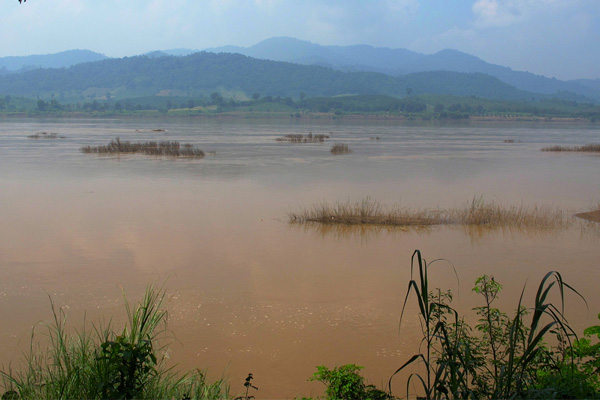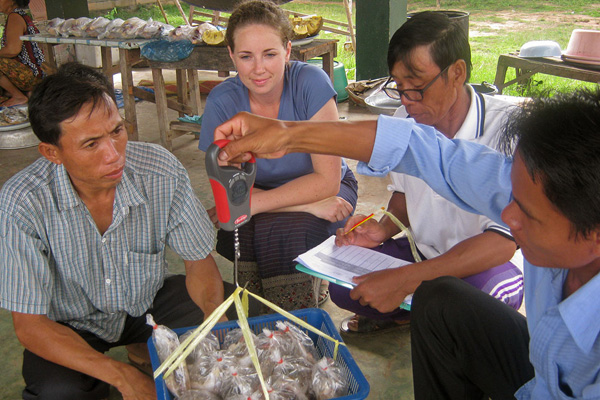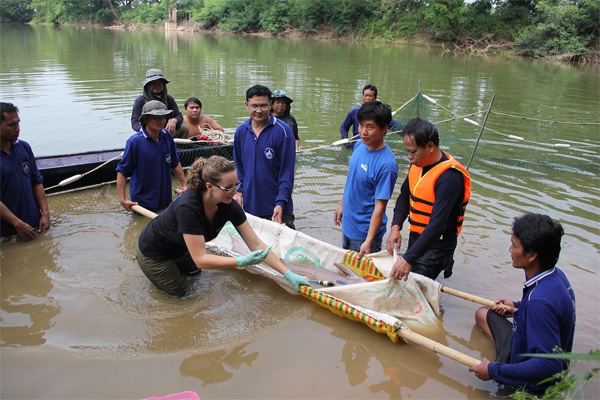Member Spotlight
|
Harmony Patricio on fish conservation in Laos November 2014 |
 |
|
Harmony sorts a fisher's catch in Laos with translater Seng Vilay (right) and a local fisherwoman. The effort to document fish species, lengths, and weights was part of a study to characterize the fishing harvest in the Nam Kading River, a tributary of the Mekong. ---------------------------------------------------------------------------------------------------------------------------------------------------------------------------------------- |
The Mekong River Basin, of Southeast Asia, supports more than 850 species of freshwater fish, a diversity of species unmatched in all but a few places in the world. More than 60 million people, from nearly 100 distinct ethnic groups, depend on this diversity of fishes for subsistence and livelihoods. This species-rich region is undergoing rapid change as development increases to ensure energy access for millions of people who live on less than $1 USD per day.
Ensuring access to energy and food security for millions of people living in extreme poverty is complicated. The current development strategy is focused on building hydroelectric dams for energy production and growing the economy. These dams could provide much-needed benefits to the region, but if they’re not built in a calculated way throughout the Basin they may carve up the river, block fish movements, and modify people’s access to their primary source of protein.
 |
|
The Mekong River in Laos. The Mekong River Basin is home to more than 850 species of freshwater fish. --------------------------------------------------------------------------------------------------------------------------------------------------------------------------------- |
Harmony Patricio is the Conservation Director for FISHBIO, an international fisheries consulting company dedicated to fish research, monitoring, and conservation. She is one of the key people driving fish research and conservation in the Lao People’s Democratic Republic (PDR), a country heavily dependent on the Mekong River and its fisheries.
Harmony has worked with local communities in Lao PDR to successfully train teams of villagers to monitor fisheries and collect essential baseline data to assess the importance of the river and aquatic animals for local livelihoods.
FISHBIO recently received funding from the Critical Ecosystem Partnership Fund (CEPF) to establish three Fish Conservation Zones (FCZs) along the Mekong River. FCZs are a type of Freshwater Protected Area that is designed to conserve or enhance fish populations. The objective of this project is to empower local communities to engage in the conservation and management of their fisheries.
The group is also working in other areas of the Mekong Basin, training local people to tag and release fish in FCZs and to then report recaptured tagged fishes. In turn, this work has demonstrated that FCZs benefit both fish and people as fish leave FCZs and contribute to local fish catches.
In the following Q&A, Harmony addresses these projects and a number of interesting topics, including the Mekong River Basin, what it’s like to be the conservation director of a private company while pursuing a Ph.D., and how being actively involved in SCBs Freshwater Working Group has strengthened her career.
You are director of Conservation for FISHBIO. What led you down this path? And why fish conservation?
I always thought I would work for a big nonprofit, but I when I met Doug (President of FISHBIO) I saw that this was a unique company and a rare opportunity. I was given the support and freedom to develop a conservation program from the ground up with an incredible team. Fish conservation allows people to see near-term benefits of conservation, which can motivate them to support wider conservation efforts.
 |
|
Training villagers in Pak Kading village to weigh fish that will be purchased at a local market. This survey was part of a study to document the economic value of fish sales in the Nam Kading River in Laos. --------------------------------------------------------------------------------------------------------------------------------------------------------------------------------- |
FISHBIO recently received funding from the Critical Ecosystem Partnership Fund (CEPF) to establish three Fish Conservation Zones (FCZs) in the Mekong River. What are these zones and why establish them in the Mekong River?
FCZs are essentially Freshwater Protected Areas that are designed specifically to conserve or enhance fish populations. We have established FCZs in the Mekong because it has a high number of threatened endemics. Also, fish are a fundamental source of food and income for local people, so communities are generally supportive of this approach.
You have been a member of SCBs Freshwater Working Group for five years. How has your involvement in this group strengthened your career?
Connections I’ve made through SCB and the FWWG are what led me to work in the Mekong. I also met my PhD supervisor through the group. Serving on the Board has given me invaluable experience in managing collaborative projects with colleagues all over the world. The time I’ve dedicated to the FWWG and experience I’ve gained wouldn’t have been possible without the support of FISHBIO.
 |
|
The Mekong River in Laos. --------------------------------------------------------------------------------------------------------------------------------------------------------------------- |
On top of your work with FISHBIO and being involved in the Society, you are also pursuing a PhD. Why did you decide to pursue a PhD?
After I finished my master’s I knew I wanted to work for a while to get more experience and hone in on where I wanted to specialize. After 5 years of working with FISHBIO I felt confident that I had found my niche. I’ve always loved school, but also want to have a positive impact in the real world. Now I’m lucky enough to get both!
Your PhD research is also on the Mekong River. What is different about the research you are pursuing and the work you do for FISHBIO and how does your research inform conservation decision making along the Mekong River?
My PhD research is linked to my work with FISHBIO, though I’m using techniques that I could not have learned or applied without the support of Griffith University. The primary difference is that my PhD work is a bit more theoretical, aiming to understand how populations and distributions have changed over time. Part of this work includes identifying critical habitat for threatened fishes, which will help to establish new FCZs to conserve them.
You have worked in a variety of ecosystems and with a diversity of fish species. Do you have a favourite?
It’s hard to choose one, but I will admit that the Mekong giant catfish has a special place in my heart. It’s the largest purely freshwater fish in the world. It grows rapidly, getting up to 350 kg, even though it only eats algae and invertebrates. We know very little about them and they’re critically endangered. This might sound strange, but I think they’re cute! They look like they’re smiling all the time; gentle and precious giants.
 |
|
Harmony works with FISHBIO staff at the Srichiangmai Inland Fisheries Research and Development Center in Thailand. The team is conducting a pilot test to tag hatchery-raised Mekong Giant Catfish with pop-up satellite archival tags to monitor movements. --------------------------------------------------------------------------------------------------------------------------------------------------------------------------------------- |
Many people think of conservation as the work of non-profits or academics, but you got your start in the Mekong Basin doing fish conservation with a private company. What is unique or different about conducting conservation work in the private sector?
I think FISHBIO is pretty unique when it comes to consulting companies. In the past I worked for small nonprofits. I found that opportunities for creative and rapid actions were limited, and we were constantly struggling for funds just to stay afloat. With FISHBIO I can design new research programs and implement them quickly. We have the freedom to use our funds the way we choose and distribute them quickly. We still look for grants, but we don’t have to worry about keeping staff on from one year to the next. We also have access to some cool hi-tech equipment that most nonprofits couldn’t afford.
Based on your own experiences working with communities to conserve freshwater biodiversity, what do you see as some of the greatest challenges the conservation world faces today?
The struggle between economic growth and conservation runs deep, and it affects nearly every aspect of our lives. There are examples showing that growth and conservation can be complementary, but ultimately consumption and associated demands for resources need to slow down. The Earth just cannot support it. Communities that live close to the land and rivers, and who directly depend on them, understand this.
What professional-oriented advice would you offer an aspiring conservation biologist who wants to pursue a career in freshwater or conservation science?
Get involved in a supportive professional society like SCB. Join relevant working groups or sections, organize symposia, and share your work. Network, network, network! You never know where a chat over a coffee break might lead. Most importantly, don’t do the work you think you “should” do. Do what fuels your fire, because if you’re passionate you will be successful.